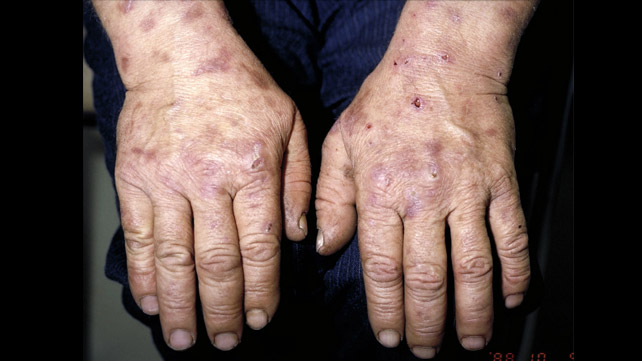|
|
Porphyria Causes, Symptoms And Prevention
Money Land Forum / Health / Porphyria Causes, Symptoms And Prevention (1 Post | 254 Views)
(1) (Go Down)
|
Porphyria Causes, Symptoms And Prevention by atoluwash(m) : 9:39 am On Nov 17, 2017 |
|
Porphyria is a group of diseases where substances called porphyrins build up, negatively impacting the skin or nervous system. The types which affect the nervous system can also be referred to as severe porphyria, as signs are rapid in onset and continue a short time. Symptoms of an attack include abdominal pain, chest pain, vomiting, confusion, constipation, fever, high blood pressure, and high heart rate. The attack usually last for days to weeks. Infection could include paralysis, low blood glucose levels, and Infection. Attacks can be triggered by alcohol, smoking, hormonal alterations, tingling, anxiety, or certain medicines. If the skin has been affected, blisters or itching can happen with sun exposure.
 Many kinds of porphyria have been inherited from a individual's parents and therefore are because of a mutation in among those genes which create heme. 1 form, porphyria cutanea tarda, might also be because of improved iron from the liver, hepatitis C, alcohol, or HIV/AIDS. The underlying mechanism leads to a drop in the sum of heme generated and also a build-up of compounds involved with making heme. Porphyrias might also be categorized by whether the liver or the bone marrowis influenced. Identification is typically by urine, blood, and stool tests. Genetic testing could possibly be done in order to ascertain the particular mutation. Porphyria (por-FEAR-e-uh) refers to a group of disorders that result from a buildup of natural chemicals that produce porphyrin in your body. Porphyrins are essential for the function of hemoglobin — a protein in your red blood cells that links to porphyrin, binds iron, and carries oxygen to your organs and tissues. High levels of porphyrins can cause significant problems.  There are two general categories of porphyria: acute, which mainly affects the nervous system, and cutaneous, which mainly affects the skin. Some types of porphyria have both nervous system symptoms and skin symptoms. Signs and symptoms of porphyria vary, depending on the specific type and severity. Porphyria is usually inherited — one or both parents pass along an abnormal gene to their child. Although porphyria can't be cured, certain lifestyle changes to avoid triggering symptoms may help you manage it. Treatment for symptoms depends on the type of porphyria you have. Symptoms Symptoms of porphyria can vary widely in severity, by type and among individuals. Some people with the gene mutations that cause porphyria never have any symptoms. Acute porphyrias Acute porphyrias contain forms of this disorder that normally cause nervous system signs, which arise quickly and may be acute. Symptoms can last days to weeks and generally enhance slowly following the attack. Acute intermittent porphyria is the frequent type of acute porphyria. Signs and symptoms of acute porphyria may include: Mental changes, such as anxiety, confusion, hallucinations, disorientation or paranoia Breathing problems Urination problems Rapid or irregular heartbeats you can feel (palpitations) High blood pressure Seizures Severe abdominal pain Pain in your chest, legs or back Constipation or diarrhea Nausea and vomiting Muscle pain, tingling, numbness, weakness or paralysis Red or brown urine Cutaneous porphyrias Cutaneous porphyrias include forms of the disease that cause skin symptoms as a result of sensitivity to sunlight, but these forms don't usually affect your nervous system. Porphyria cutanea tarda (PCT) is the most common type of all the porphyrias. As a result of sun exposure, you may experience: Fragile thin skin with changes in skin color (pigment) Itching Excessive hair growth in affected areas Red or brown urine Sensitivity to the sun and sometimes artificial light, causing burning pain Sudden painful skin redness (erythema) and swelling (edema Blisters on exposed skin, usually the hands, arms and face Causes All sorts of porphyria involve an issue in the production of heme. Heme is a part of hemoglobin, the protein in red blood cells which carries oxygen from the lungs to all areas of the human body. Heme manufacturing, which happens from the bone marrow and liver, also entails eight distinct enzymes -- a lack (lack) of a particular receptor determines the sort of porphyria. In cutaneous porphyria, the porphyrins build up in the skin, and if subjected to sunlight, trigger symptoms. In acute porphyrias, the buildup damages the nervous system. Prevention Even though there's no method to reduce porphyria, when you've got the disorder, prevent triggers to help avoid symptoms. Since porphyria is generally an inherited illness, your grandparents and other relatives might wish to think about genetic testing to establish whether they have the disorder, also get genetic counselling if necessary. Source: https://aderonkebamidele.com/porphyria-causes-symptoms-prevention/ |
(1) (Reply)
Baby Fighting For Life After Drinking Common Household Product / 8tips to stay healthier / 6 Alarming Symptoms of Low Potassium Levels in the Body /
(Go Up)
| Money Land Forum - Copyright © 2016 - 2024 | Aderonke Bamidele (Admin). All rights reserved. Follow Money Land Forum on Facebook and Twitter Disclaimer: Every Money Land Forum member is solely responsible for anything that he/she posts or uploads on Money Land Forum. |

